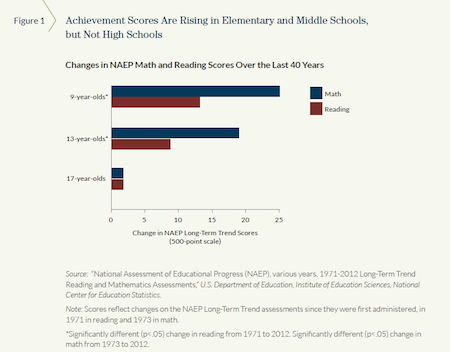I have a new report out this week called “Mind the Gap: The Case for Re-Imagining the Way States Judge High School Quality.” I hope you’ll give it a read.
I’ll be blogging about it all week, starting today with a look at why we even need high school accountability systems at all. As I point out in the paper, we’re in the midst of a strange paradox. Reading and math achievement levels are increasing for 4th- and 8th-graders, but they’ve barely budged for high school students. High school graduation rates are at all-time highs, and more students are going to and persisting in college, but college dropouts are now a bigger problem than high school dropouts.
The graph below shows what the trend in achievement scores looks like. Since 1973, math scores for the average 9-year-old have risen 25 points (on a 500-point scale). Scores for the average 13-year-old are up 19 points. Both of these are statistically and practically significant. But the average 17-year-old today is scoring only 2 points higher than the average 17-year-old in 1973, and even that small gain is not statistically distinguishable from 1973.
The same pattern emerges in reading, just with smaller increases for 9- and 13-year-olds.

Before I provide one possible solution for how we can change this situation, I want to first discuss two unsatisfactory theories about why high school progress has been so much slower:
1. Simpson’s Paradox. As I’ve written before, a mathematical quirk known as Simpson’s Paradox can distort an overall trend when the composition of groups that make up the trend change over time. As the United States population has become more diverse, a representative sample of students picks up more and more minority students, who tend to score lower overall than white students. That can make our overall scores appear flat, even as all of the groups that make up the overall score improve markedly.
Simpson’s Paradox is masking gains in many areas of American education, and it is here too. Once we separate the scores by student subgroups, the gains look much better. Here are the math score gains by race since 1973:
White students: + 4 points
Black students: +18 points
Hispanic students: +17 points
All of these are better than the national average, all are statistically significant, and the gains for black and Hispanic students are particularly impressive. That’s great news, but it still doesn’t entirely explain why high school progress has been so much slower than the gains for younger students. Plus, there’s no reason to believe Simpson’s Paradox is somehow worse for high school students. Although the demographic make-up of 17-year-old test-takers has changed over time, the same is true for 9- and 13-year-olds, and the magnitude of demographic changes looks nearly identical across all grade levels. In short, Simpson’s Paradox is masking some gains at the high school level, but it doesn’t explain why high school students are not growing as much as elementary or middle school students.
2. Student motivation. This is a common explanation, but it’s probably wrong. You hear it in various forms, from grumbling about “kids these days” or the latest video games or lack of interest in no-stakes bubble tests. But the divergence among grade levels cannot be simply due to differences in motivation. NAEP is not just a multiple choice test—it also requires students to engage with the material and respond in writing. On those more complicated portions of NAEP, high school students have relatively similar response and engagement rates as elementary and middle school students have (see here for example), suggesting that older students are not less motivated to perform than younger students.
So how do we start kickstart achievement for high school students? It’s not by doubling down on graduation rates–those are at all-time highs already. And, in a world where more than 80 percent of high school students graduate on time and 90 percent go on to earn some form of high school diploma, the low-hanging fruit has all been picked.
The current focus on low-level academic skills and high school graduation rates has proved useful, but it won’t be sufficient to drive dramatic improvements going forward. Instead, states must develop new ways of defining success and ensuring that high schools are truly preparing students for college or careers.
Read my full report, or check back here throughout the week, for my recommendations on how to get there.
—Chad Aldeman
This post originally appeared on Ahead of the Heard.


